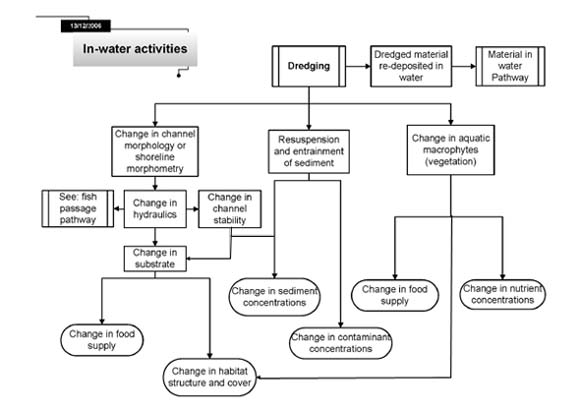Dredging
In-Water Activities
- Addition or removal of aquatic vegetation
- Change in timing, duration and frequency of flow
- Dredging
- Fish passage issues
- Marine seismic surveys
- Organic debris management
- Placement of material or structures in water
- Structure removal
- Use of explosives
- Use of industrial equipment
- Wastewater management
- Water extraction
The physical removal of materials including rocks, bottom sediments, plants, debris, sand, and refuse from the bed of a water body/watercourse for the purpose of excavating, cleaning, deepening, widening, or lengthening the watercourse. This requires the use of a dredge machine working from the bank, in the water or floating on water.
NOTE:
Pathways of Effects diagrams have been developed by Fisheries and Oceans Canada as a tool to communicate potential effects of development proposals on fish and fish habitat and were developed through extensive consultation. It is expected that these diagrams will be updated to describe new activities and stressors as required.

Effects
Change in food supply: The aquatic food supply must be plentiful and diverse to sustain the productivity of a watershed. An increase or decrease in the quantity or composition of the food supply, beginning with plants and organic debris that fall into a waterway, can alter the structure of the aquatic community.
Change in habitat structure and cover: The addition of in-stream organic structure and the deposition of eroded soil can affect the capacity of a watercourse to maintain a dispersed and diverse community of aquatic organisms by restricting habitat connectivity and the opportunities for organisms to use, colonize, and move between existing aquatic environments. The removal of in-stream and riparian vegetation can reduce channel stability, cover and protection from predators and physical disturbances, and the availability of diverse and stable habitats.
Change in sediment concentrations: Increased erosion of stream bank soils and rocks result in an excess of fragmented organic and inorganic material which is transported by water, wind, ice, and gravity. These sediments, which contain nutrifying elements and can capture or absorb contaminants, are suspended or else settle and collect in waterways affecting physical processes, structural attributes, and ecological conditions such as water clarity (by reducing visibility and sunlight and damaging fish gills) and reducing the availability and quality of spawning/ rearing habitat (through infilling).
Change in contaminant concentrations: An increase in concentrations of toxins and pollutants in sediments and waters can breach the range of chemical parameters that support healthy aquatic communities, seriously affecting fish and fish habitat. The ecological effects can range from direct fatality to organisms, alteration of the ecosystem structure through changes in the abundance, composition, and diversity of communities and habitats, and persistence and progressive accumulation in sediments or biological tissues (bioaccumulation, biomagnification). Deformities, alterations in growth, reproductive success, and competitive abilities can result.
Change in nutrient concentrations: Some activities may cause an increase in nutrifying elements such as nitrogen and phosphorus and mineral compounds such as ammonia, nitrates, nitrites, orthophosphates. This leads to 'eutrophication', thick growths of aquatic plants (especially algae) that block light needed by aquatic vegetation, either by clouding the water column or coating the vegetation itself. When the algae die, they settle to the bottom and are consumed by bacteria during the decomposition process. This process consumes oxygen, depleting it from bottom waters. The resulting low dissolved oxygen concentrations drive fish from their preferred habitat and can cause other organisms to die.
- Date modified: